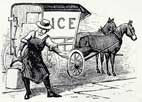


Imagine not having a refrigerator or a freezer to keep food, drinks, ice cream, meat and all those other things we count on being available and unspoiled whenever we open those appliance doors. In the “old days”, how did people keep food cold in the summer so it would stay fresh longer and meat would not spoil? Yes, people had root cellers under their houses which were cool, but not cold. And some people kept food in well shafts which kept the items cooler because they were below ground level.
In Dublin, as in most towns and villages, before refrigeration was available, people solved the problem with ice! They keet food very cold using blocks of ice long into the hot summer, and the Scioto River played a role helping Dubliners with this. Read about the Ice House, where blocks of ice were stored before being taken to peoples’ houses and put into “ice boxes”, the forerunner of the modern refrigerator.
The Ice House
Ice is one of the greatest of summer luxuries, and indeed is almost a necessity. It is so easily put up, even in the country, and so cheaply protected, that there is no reason why any one who is able to own or rent a house may not have it in liberal supply. A cheap ice-house may be made by partitioning off a space about twelve feet square in the wood-shed, or even in the barn. The roof must be tight over it, but there is no necessity for matched or fine lumber for the walls. They should, however, be coated with coal-tar inside, as the long continued moisture puts them to a severe test and brings on decay. Ice should be taken from still places in running streams, or from clear ponds. It may be cut with half an old cross-cut saw, but there are saws and ice-plows made for the purpose to be had in almost every village. In cutting ice, as soon as it is of sufficient thickness and before much warm weather, select a still day, with the thermometer as near zero as may be. Ice handles much more comfortable and easily when it is so cold that it immediately freezes dry, thus preventing the wet clothes and mittens, which are the sole cause of any suffering in handling it; and ice put up in sharp, cold weather, before it has been subjected to any thaw, will keep much better and be much more useful in the hot days of summer than if its packing had been delayed until late winter or early spring, and then the ice put up half melted and wet. The best simple contrivance for removing blocks of ice from the water is a plank with a cleat nailed across one end, which is to be slipped under the block, which slides against the ice and may then be easily drawn out with the plank, without lifting. Cut the ice in large blocks of equal size, pack as closely as possible in layers, leaving about a foot space between the outside and the wall, and filling all crevices between the blocks with pounded ice or sawdust. Under the first layer there should be placed sawdust a foot thick, and arrangements should be made for thorough drainage, as water in contact with the ice will melt it rapidly.
Excerpt from Buckeye Cookery and Practical Housekeeping, Buckeye Publishing Company, 1879
Madge Shriver’s recollections of growing up in Dublin include this passage about the ice house:
“We used to have an ice house. It was real thick wood, insulated, then had sawdust in it. And in the wintertime, they’d go down to the river and cut ice. My brother fell in one time when they were cutting ice and almost drowned…But I can remember going up in that (ice house). You got up into this upper part with a ladder. And then they’d have these ice tongs to pull out these big hunks of ice. And then he had a big cooler called an ice box, which you put ice up on the top, and food down on the bottom.”
Source: Shanachie Magazine, A Publication of Dublin History and Culture, Volume III, Dublin High School, Spring 1998.
Another of Madge Shriver’s recollections of her family’s store is this:
“Grandfather had an ice house right on the corner all filled with sawdust and ice they cut down at the river. They hauled them up the bank with a horse. They loaded them just like bales of hay.”
Source: Shanachie, Volume II, Spring 1985
There is record of one Dublin resident who lost his life in an ice-house accident.
“Joseph T. Bower, 1832-1881. When ice was being cut to store in the ice house for summer use, a big cake fell on Joseph, which caused his death.”
Source: (Bower history, “Memories” Dublin Historical Society, 1997)
The following is not a Dublin reference, but complements the Dublin resources and is representative of ice harvesting.
The reader can tell these blocks of ice were large, a “…standard size, 22 inches by 12 inches, weighing about a hundred pounds. Sometimes the cakes were broken apart with a boar (bar), but particular people liked to have the edges smooth, so the last two or three inches were sawed by hand. The ice saw was straight-bladed and four or five feet in length with a handle like a lawn mower. After the cakes were cut, they were poled through the dark water to shore. Here a long plank sloped into the water; the trick was to give the cake of ice enough momentum so that its weight would carry it up where someone with a pair of tongs could snag it…the ice was hauled to the ice house on two-horse bobsleds. Layer by layer the old weathered ice house was filled. A sprinkling of dry sawdust was scattered between each layer of cakes. This made them easier to separate when they were taken out. A two-foot-wide layer of sawdust was tamped lightly between the ice and the sides of the building. After the last layer was pushed up the long, oak plank, the whole heap was covered a yard deep with sawdust. Some farmers not only cut ice for their own needs, but for their neighbors. The going price was five cents a cake…It took an average of three humdred cakes to last a family through the summer; at five cents a cake this was fifteen dollars, one-third the price of a good cow.”
Source: The Good Old Days, Ice Harvest, R.J. McGinnis, F.&W. Publishing Company, Cincinnati, OH, pages 121-122., and found on the website of the Tallgrass Prairie National Preserve, United States Park Service.

